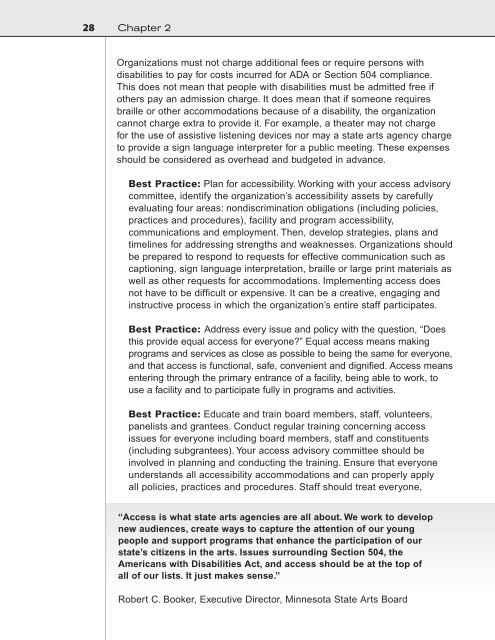Design for Accessibility: A Cultural Administrator's Handbook
Design for Accessibility: A Cultural Administrator's Handbook
Design for Accessibility: A Cultural Administrator's Handbook
You also want an ePaper? Increase the reach of your titles
YUMPU automatically turns print PDFs into web optimized ePapers that Google loves.
28 Chapter 2<br />
Organizations must not charge additional fees or require persons with<br />
disabilities to pay <strong>for</strong> costs incurred <strong>for</strong> ADA or Section 504 compliance.<br />
This does not mean that people with disabilities must be admitted free if<br />
others pay an admission charge. It does mean that if someone requires<br />
braille or other accommodations because of a disability, the organization<br />
cannot charge extra to provide it. For example, a theater may not charge<br />
<strong>for</strong> the use of assistive listening devices nor may a state arts agency charge<br />
to provide a sign language interpreter <strong>for</strong> a public meeting. These expenses<br />
should be considered as overhead and budgeted in advance.<br />
Best Practice: Plan <strong>for</strong> accessibility. Working with your access advisory<br />
committee, identify the organization’s accessibility assets by carefully<br />
evaluating four areas: nondiscrimination obligations (including policies,<br />
practices and procedures), facility and program accessibility,<br />
communications and employment. Then, develop strategies, plans and<br />
timelines <strong>for</strong> addressing strengths and weaknesses. Organizations should<br />
be prepared to respond to requests <strong>for</strong> effective communication such as<br />
captioning, sign language interpretation, braille or large print materials as<br />
well as other requests <strong>for</strong> accommodations. Implementing access does<br />
not have to be difficult or expensive. It can be a creative, engaging and<br />
instructive process in which the organization’s entire staff participates.<br />
Best Practice: Address every issue and policy with the question, “Does<br />
this provide equal access <strong>for</strong> everyone?” Equal access means making<br />
programs and services as close as possible to being the same <strong>for</strong> everyone,<br />
and that access is functional, safe, convenient and dignified. Access means<br />
entering through the primary entrance of a facility, being able to work, to<br />
use a facility and to participate fully in programs and activities.<br />
Best Practice: Educate and train board members, staff, volunteers,<br />
panelists and grantees. Conduct regular training concerning access<br />
issues <strong>for</strong> everyone including board members, staff and constituents<br />
(including subgrantees). Your access advisory committee should be<br />
involved in planning and conducting the training. Ensure that everyone<br />
understands all accessibility accommodations and can properly apply<br />
all policies, practices and procedures. Staff should treat everyone,<br />
“Access is what state arts agencies are all about. We work to develop<br />
new audiences, create ways to capture the attention of our young<br />
people and support programs that enhance the participation of our<br />
state’s citizens in the arts. Issues surrounding Section 504, the<br />
Americans with Disabilities Act, and access should be at the top of<br />
all of our lists. It just makes sense.”<br />
Robert C. Booker, Executive Director, Minnesota State Arts Board


